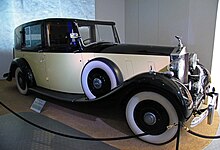Rolls-Royce Phantom III
| Rolls Royce | |
|---|---|
|
Rolls-Royce Phantom III (1936)
|
|
| Phantom III | |
| Production period: | 1936-1939 |
| Class : | Upper class |
| Body versions : | Limousine , coupe , Pullman limousine , convertible , landaulet |
| Engines: |
Otto engine : 7.3 liters (134 kW) |
| Length: | 5410 mm |
| Width: | 1905 mm |
| Height: | |
| Wheelbase : | 3607 mm |
| Empty weight : | 1837-3500 kg |
| Previous model | Rolls-Royce Phantom II |
| successor |
Rolls-Royce Silver Wraith Rolls-Royce Phantom IV |

The Rolls-Royce Phantom III was the last great Rolls-Royce before World War II . The vehicle was introduced in 1936 and replaced the Phantom II . It was the only Rolls-Royce with a V12 engine until the introduction of the Silver Seraph in 1998. 727 chassis of the Phantom III had been produced by 1939, many of which still exist.
description
The V12 engine of the Phantom III has a displacement of 7341 cm³ (bore × stroke = 82.55 mm² × 114.3 mm) and an aluminum engine block. The overhead valves are controlled by a single camshaft located between the cylinder banks. Early designs had hydraulic valve clearance compensation via a system of eccentric discs on the rocker arms, which were moved by a hydraulic piston, and ensured that there was no play between rocker arm and valve. In 1938 this system was abandoned in favor of fixed, manually adjustable rams. The double ignition of the Phantom III, which consists of two distributors, two ignition coils and 24 spark plugs, is also unusual . The fuel is delivered to the carburettors by two electric SU pumps. The engine develops an output of 134 kW. With the revised engine, the Phantom III reaches a top speed of 161 km / h. The Phantom III had wire-spoke wheels as standard, but many cars were fitted with "Ace" disc wheels.
The cars were equipped with central lubrication that was operated with a lever in the driver's cab. The independent front suspension on double wishbones with coil springs was new ; the rear axle with its semi-elliptical longitudinal leaf springs was taken over from its predecessor. The four-speed transmission was synchronized in gears 2, 3 and 4. From 1938 there was an overdrive . The mechanical brake booster for the cable brakes on all four wheels was manufactured under license from Hispano-Suiza . The radiator frame was made of Staybrite steel.
The sheer weight of the cars can be seen in their performance data. A copy tested by the English magazine Autocar in 1938 reached a top speed of 140 km / h and accelerated from 0-100 km / h in 16.8 seconds. The gasoline consumption measured in this test was 28 liters per 100 km.
Bodies
Only the chassis and mechanics were made by Rolls-Royce. The bodies were built by a wheelwright at the customer's request . Some of the best known coachbuilders for Rolls-Royce automobiles were Park Ward , Thrupp & Maberly , Mulliner, and Hooper . On the European continent, among others, Vesters & Neirinck in Brussels manufactured high-quality bodies for the Phantom III.
James Bond's Rolls-Royce Phantom III

The Rolls-Royce Phantom III also gained notoriety through its appearance in the James Bond film Goldfinger as the vehicle of Auric Goldfinger and his bodyguard Oddjob. Two similar vehicles were used for the film; the better known with the chassis number 3BU168 has a Sedanca de Ville body from Barker .
literature
- David Culshaw, Peter Horrobin: The Complete Catalog of British Cars 1895-1975. New edition. Veloce Publishing plc., Dorchester 1997, ISBN 1-874105-93-6 .
Web links
Individual evidence
- ^ A b c Barlow, Roger: Rolls-Royce Phantom III: Smooth as clean oil, as long as the oil was clean . Published in Autoweek . 5th October 1987
- ^ A b c Michael Conradt: High nobility: Rolls-Royce 12-cylinder from English aristocracy, which were sold to Germany. In: Auto, Motor und Sport. Issue 25, 1977, ISSN 0005-0806 , pp. 72-82.
